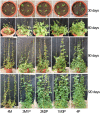Priority effects and competition by a native species inhibit an invasive species and may assist restoration
- PMID: 33304543
- PMCID: PMC7713920
- DOI: 10.1002/ece3.6938
Priority effects and competition by a native species inhibit an invasive species and may assist restoration
Abstract
Selecting native species for restoration is often done without proper ecological background, particularly with regard to how native and invasive species interact. Here, we provide insights suggesting that such information may greatly enhance restoration success. The performance of the native vine, Pueraria lobata, and that of the invasive bitter vine, Mikania micrantha, were investigated in South China to test how priority effects (timing and rate of germination and seedling growth) and competition (phytochemical effects and competitive ability) impact invasive plant performance. We found that, in the absence of competition, the germination rate of M. micrantha, but not of P. lobata, was significantly affected by light availability. P. lobata seedlings also performed better than those of M. micrantha during early growth phases. Under competition, negative phytochemical effects of P. lobata on M. micrantha were strong and we found M. micrantha to have lower performance when grown with P. lobata compared to when grown by itself. Relative interaction indexes indicated that, under interspecific competition, P. lobata negatively affected (i.e., inhibited) M. micrantha, whereas M. micrantha positively affected (i.e., facilitated) P. lobata. Higher photosynthetic efficiency and soil nutrient utilization put P. lobata at a further advantage over M. micrantha. Field trails corroborated these experimental findings, showing little recruitment of M. micrantha in previously invaded and cleared field plots that were sown with P. lobata. Thus, P. lobata is a promising candidate for ecological restoration and for reducing impacts of M. micrantha in China. This research illustrates that careful species selection may improve restoration outcomes, a finding that may also apply to other invaded ecosystems and species.
Keywords: Mikania micrantha; Pueraria lobata; biotic interactions; competitive exclusion; ecological restoration; priority effect.
© 2020 The Authors. Ecology and Evolution published by John Wiley & Sons Ltd.
Conflict of interest statement
None declared.
Figures







References
-
- Anderson, J. M. , Chow, W. S. , & Goodchild, D. J. (1988). Thylakoid membrane organization in sun/shade acclimation. Australian Journal of Plant Physiology, 15, 11–26.
-
- Armas, C. , Ordiales, R. , & Pugnaire, F. I. (2004). Measuring plant interactions: A new comparative index. Ecology, 85(10), 2682–2686. 10.1890/03-0650 - DOI
-
- Bentley, K. E. , & Mauricio, R. (2016). High degree of clonal reproduction and lack of large‐scale geographic patterning mark the introduced range of the invasive vine, kudzu (Pueraria montana var. lobata), in North America. American Journal of Botany, 103(8), 1499–1507. 10.3732/ajb.1500434 - DOI - PubMed
LinkOut - more resources
Full Text Sources

